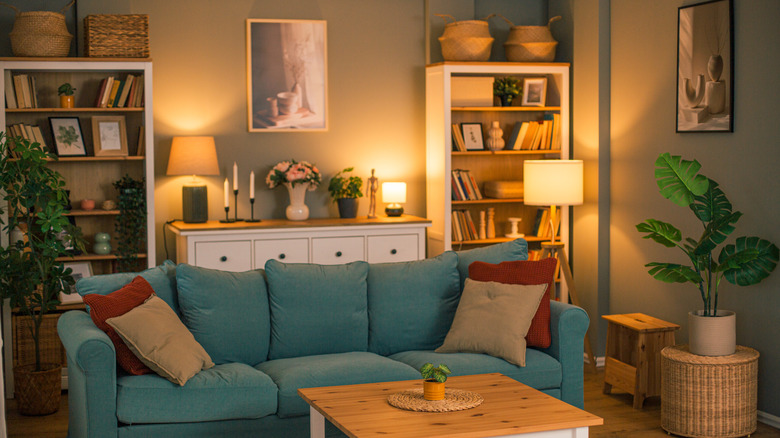The Lighting Mistake That Is Making Your Home Look (& Feel) Staged
The lighting in your home does more than illuminate your surroundings. It sets the tone for the room, influences how colors in your home appear, and can even affect your mood, making it a key piece of a well-designed space. If your home feels harsh and staged, you may be making a common lighting mistake: relying solely on overhead lights. Overhead lighting is useful in that it helps to distribute light throughout a room evenly, and, depending on the light fixture, it can even be a fun accent to your home decor. But using only overhead lights rather than a mixture of light sources makes your home feel like a showroom.
Here's the good news: you don't need to rip out your lights to make your home feel more inviting and less staged. Instead, a couple of additions in the form of lamps, sconces, and dimmers can make all the difference. And of course, don't forget about natural lighting. Opening up the curtains and blinds or trying any of these 25 best ways to improve natural light in your home can go a long way in eliminating the need to always have the overhead lights running.
How to improve your home's lighting
A collection of different light sources allows you to customize your home's mood and brightness based on the activity at hand. One of the easiest ways to do this is by adding lamps to your spaces. Lamps are available in numerous sizes, shapes, and designs, making it easy to vary the texture and height, allowing lamps to double as cozy light sources and pieces of beautiful home decor. In addition to lamps, cordless wall lighting ideas to brighten your home, like sconces with battery powered lights, offer an electrician-free way to add task lighting. You can place these on either side of your bed to use at reading lights, or along a hallway for dim illumination at night.
You can even try Nate Berkus' smart lighting tip to keep your home zen — use dimmers. A plugin dimmer added to a lamp or a dimmer switch connected to your overhead lighting allows you to manually adjust the lighting level in the home, preventing a harsh, fluorescent-like feel. The color temperature of your light bulbs can also transform the space. A warm white light bulb can create a cozy, inviting space while a cool-toned or daylight bulb adds brightness, which can be helpful in places like windowless bathrooms or basements. It may take a while for you to strike that perfect balance, so play around with additional light sources and color temperatures until you achieve the look and mood you're after.

